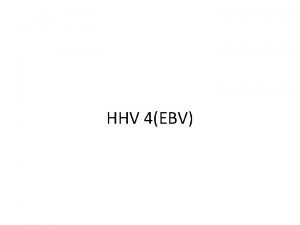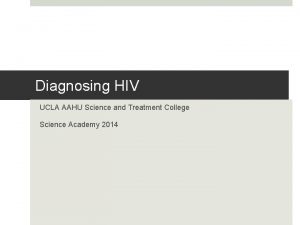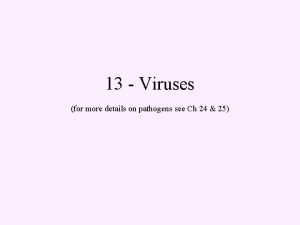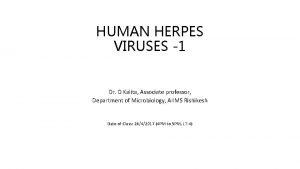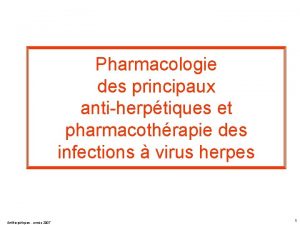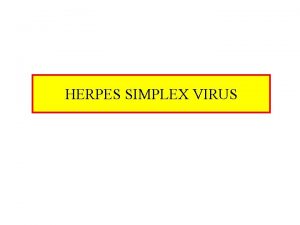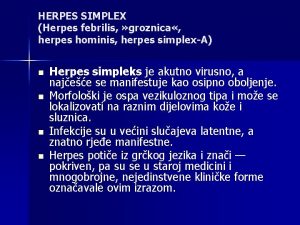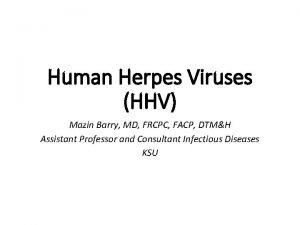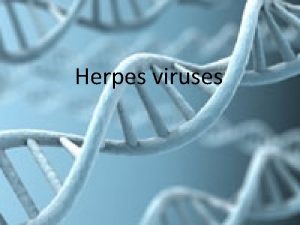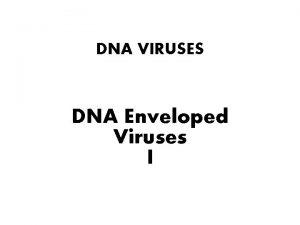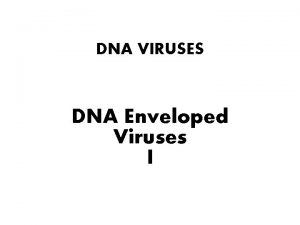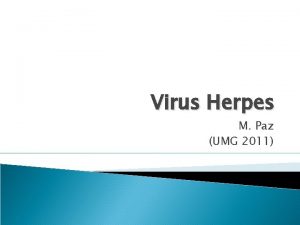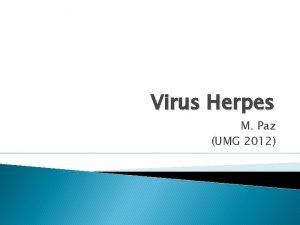Human herpes virus infections HHV HERPES VIRUSES Enveloped









- Slides: 9

Human herpes virus infections HHV

HERPES VIRUSES: Enveloped , ds. DNA viruses. Similar morphologically • but differ clinically and biologically. Three groups: 1 -ALPHA-HRPES VIRUSES(HSV-1, HSV-2, AND VZV). • 2 -BETA-HERPESVIRUSES(CMV, HUMAN • HERPESVIRUSES(HHV)-6 AND HHV-7, SIMIAN HERPES B). 3 -GAMMA-HERPESVIRUSES(EBV AND HHV-8). •

There are eight human herpes virus, they are capable • of establishing life long latency after acute infections, and are also capable for oncogenesis and reactivation under certain conditions, these are DNA viruses and divided into subgroups according to their site of latency and their infectious manifestations. HHV are acquired by direct contact with clinically active infected person or through asymptomatic shedding of virus, for many HHV infected saliva is a common source of infection, sexual contact, intrauterine infection and acquiring the infection at time of delivery, blood transfusion , and transmission at time of transplantation are modes of acquisition depending on HHV type. .

Airborne infection occurred only with • VZV, humoral immunity is required to protect against primary infection but after infection is established it does not control its spread. The cell mediated immune system is responsible for controlling spread, transmission, and severity of HHV infections. Infection prevention relies on screening, safe sexual practices, and infection control measures. Vaccines exist only for VZV. Effective antiviral medications are available for treatment and reducing of reactivation of some of the HHVs. Immunoglobuloin preparation for VZV and CMV are indicated under certain circumstances in immunocompromised persons.

Although they are closely related and cause similar diseases, • herpes simplex viruses 1 and 2 (HSV-1 and HSV-2) are genetically and serologically distinct. HSV-1 infection • occurs earlier in life, with nearly 90% of adults worldwide having detectable antibodies by age 40 years. • HSV-2 is less prevalent, ranging from 20% to 60% depending on number of sexual partners, sex, and • geographic location. Numerous infection syndromes are caused by HSV, depending on • the virus type, host age, immune status, and anatomic site involved. HSV-1 most frequently manifests as • gingivostomatitis and pharyngitis • HSV-2 is a common cause of genital ulcer disease worldwide • Primary genital infection during pregnancy may be transmitted to the fetus • and lead to spontaneous abortion. Although recurrent infection occurs more often during pregnancy, • neonatal outcome is usually unaffected in seropositive women. •

HSV-1 and HSV-2 may cause other cutaneous • manifestations, including infection of the finger (herpetic whitlow) or skin (herpes gladiatorum). Involvement of the eye, with keratitis and acute retinal necrosis, occurs infrequently. Proctitis may occur secondary to anal intercourse. HSV infection (primarily HSV-1) is the most common cause of nonepidemic viral encephalitis. Aseptic (sometimes recurrent) meningitis, sacral radiculopathy, and transverse myelitis may also occur after HSV-2 genital infection. Infection of visceral organs, including the esophagus, lung, and liver, may result from viremia or direct extension from nearby mucosal surfaces. The common association of • erythema multiforme and HSV infection is a consequence of the host's immune response to the virus. • • •

Management: The nucleoside analogues acyclovir, valacyclovir, • and famciclovir are effective for treating episodic HSV-1 and HSV-2 infections and suppressing recurrent • infections. Topical antiviral agents have limited usefulness for treating mucocutaneous disease; however, • they are recommended for treatment of HSV eye infections. Intravenous acyclovir is required to treat HSV • encephalitis. No studies of efficacy of systemic antiviral therapy for HSV aseptic meningitis exist. •

SEVERE MUCOCUTANEOUS HERPES SIMPLEX IN RENAL TRANSPLANT RECEPIENT

PRIMARY HERPES SIMPLEX JINJIVOSTOMATITIS IN A CHILD


